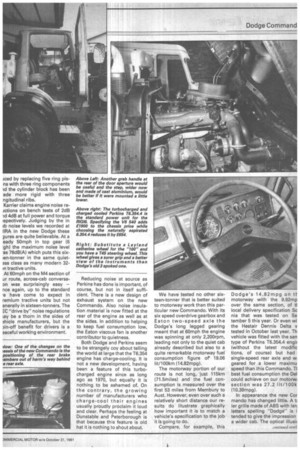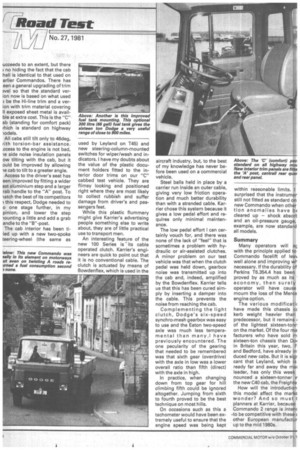New breed of sixteen-tonne
Page 36

Page 37

Page 38

If you've noticed an error in this article please click here to report it so we can fix it.
The old days of lOnnpg for 10-ton loads by max-weight two-axle rigids have passed, reports Tim Blakemore
WAS when a rough and dy benchmark by which the formance of a sixteen-tonner ild be judged was that it )uld be able to carry ten tons I be capable of a fuel connption of lOmpg. This week's d test of the Dodge Cornndo 2 sixteen-tonner shows any that these criteria will fa to be forgotten when judgthe latest breed of maxim-weight two-axle rigids. Vith a payload of almost 101/2
s, the R1G16 set a fuel conmption record of 2 0.8 2 100km (13.57mpg) over CM's Ish route for middleweights. it is not merely a marginal wovement over the previous t, achieved by the Magirus Deutz in our group test of last year, but over one mile per gallon or 8.8 per cent better.
Compared with the old style Commando that was tested in the same group, the fuel consumption improvement with the new model is 16.4 per cent. Dodge's own trials with in-service vehicles fitted with the new specification Perkins T6.354.4 are said to have shown fuel savings of between 12 and 15 per cent, but unlike our test vehicle these were not fitted with the now standard viscous fan.
Engine changes The engine programme is regarded by Karrier Motors as "the single most important aspect of the Commando 2 project".
The Mercedes 0M352 engine which used to be an option on G11-G16 chassis is no longer offered — hardly surprising, when you consider that its price is so high; few operators specified it anyway, and of course Daimler-Benz is one of Renault Vehicules Industriel's great European rivals. (RVI acquired a 50 per cent interest in Karrier last April, the other 50 per cent belonging to the Peugeot-Citroen group. One Renault man was overheard to say, "Our half is bigger than theirs.") Nevertheless, the range of engine options (albeit from a single manufacturer — Perkins) remains unusually wide.
Among sixteen-tonners the choice is between the 128bhp, naturally aspirated 6.354.4; the 14 Bbhp, turbocharged and charge-cooled T6.354.4; and the 172bhp, naturally aspirated V8.540. Renault's decision makers at Karrier have realised that many operators liked t original 100-Series because its many options for the choi of gearboxes and single or tv% speed axles will also continue be available.
The most recent changes the Perkins engines, announc at the Frankfurt Show, are aim at improving fuel economy a durability, and reducing noi levels. Turbocharged units e now equipped with Bosch EP/ fuel-injection equipment. Le noise, improved fuel consurr tion and reduced smoke em sion results from faster injecti occurring later in the cycle, a "low inertia" injectors a claimed to eliminate needle t unce.
Frictional loss have been
Aced by replacing five ring pisns with three ring components id the cylinder block has been ade more rigid with three ngitudinal ribs.
Karrier claims engine noise reictions on bench tests of 2dB id 4dB at full power and torque !spectively. Judging by the in ib noise levels we recorded at IIRA in the new Dodge these ;ures are quite believable. At a eady 50mph in top gear (6 gh) the maximum noise level as 76dB(A) which puts this sixien-tonner in the same quietass class as many modern 32in tractive units.
At 60mph on the M4 section of ur route, across-cab conversecm was surprisingly easy — nce again, up to the standard 'e have come to expect in remium tractive units but not enerally in sixteen-tonners. The EC "drive by" noise regulations lay be a thorn in the sides of ahicle manufacturers, but the in-off benefit for drivers is a aaceful working environment. Reducing noise at source as Perkins has done is important, of course, but not in itself sufficient. There is a new design of exhaust system on the new Commando. Also noise insulation material is now fitted at the rear of the engine as well as at the sides, In addition to helping to keep fuel consumption low, the Eaton viscous fan is another contributor to quietness.
Both Dodge and Perkins seem to be strangely coy about telling the world at large that the T6.354 engine has charge-cooling. It is not a new development, having been a feature of this turbocharged engine since as long ago as 1970, but equally it is nothing to be ashamed of. On the contrary, the growing number of manufacturers who charge-cool their engines usually proudly proclaim it loud and clear. Perhaps the feeling at Dunstable and Peterborough is that because this feature is old hat it is nothing to shout about. We have tested no other sixteen-tonner that is better suited to motorway work than this particular new Commando. With its six speed overdrive gearbox and Eaton two-speed axle the Dodge's long [egged gearing meant that at 60mph the engine was spinning at only 2,200rpm, leading not only to the quiet cab already described but also to a quite remarkable motorway fuel consumption figure of 19.06 lit/100km (14.82mpg).
The motorway portion of our route is not long, just 115km (71.5miles) and the fuel consumption is measured over the first 53 miles from Membury to Aust. However, even over such a relatively short distance our results do illustrate graphically how important it is to match a vehicle's specification to the job it is going to do.
Compare, for example, this Dodge's 1 4.82mpg on motorway with the 9.92mp over the same section, of ti local delivery specification Sc nia that was tested on Se tember 5 this year. Or even wi the Hestair Dennis Delta v tested in October last year. Th vehicle was fitted with the san type of Perkins T6.354.4 engit (without the latest modific tions, of course) but had single-speed rear axle and w. geared for a lower maximu speed than this Commando. TI best fuel consumption the Del could achieve on our motor= section was 27.2 lit/100k (10.39mpg).
In appearance the new Cor mando has changed little. A t ler grille made of ABS with Ian letters spelling "Dodge" is i tended to give the impression a wider cab. The optical illusi( ucceeds to an extent, but there ; no hiding the fact that the cab hell is identical to that used on arlier Commandos. There has een a general upgrading of trim neel so that the standard verion now is based on what used ) be the Hi-line trim and a verion with trim material covering II exposed sheet metal is availble at extra cost. This is the "C" ab (standing for comfort pack) rhich is standard on highway All cabs still tilt only to 46deg, rith torsion-bar assistance. .ccess to the engine is not bad, le side noise insulation panels ow tilting with the cab, but it ould be improved by allowing le cab to tilt to a greater angle. Access to the driver's seat has een improved by fitting a wider ast aluminium step and a larger rab handle to the "A" post. To latch the best of its competitors this respect, Dodge needed to o one stage further, in my pinion, and lower the step vaunting a little and add a grab andle to the "B"-post.
The cab interior has been tiled up with a new two-spoke Leering-wheel (the same as used by Leyland on T45) and new steering-column-mounted switches for wiper/wash and indicators. I have my doubts about the value of the plastic document holders fitted to the interior door trims on our "C" cabbed test vehicle. They are flimsy looking and positioned right where they are most likely to collect rubbish and suffer damage from driver's and passengers feet.
While this plastic flummery might give Karrier's advertising people something else to write about, they are of little practical use to transport men.
An interesting feature of the new 100 Series is its cable operated clutch. Karrier's engineers are quick to point out that it is no conventional cable, The clutch is actuated by means of Bowdenflex, which is used in the aircraft industry, but, to the best of my knowledge has never before been used on a commercial vehicle.
Steel balls held in place by a carrier run inside an outer cable, giving very low friction operation and much better durability than with a stranded cable. Karrier chose this system because it gives a low pedal effort and requires only minimal maintenance.
The low pedal effort I can certainly vouch for, and there was none of the lack of "feel" that is sometimes a problem with hydraulic or air-assisted clutches. A minor problem on our test vehicle was that when the clutch pedal was held down, gearbox noise was transmitted up into the cab and, indeed, amplified by the Bowdenflex. Karrier tells us that this has been cured simply by inserting a damper into the cable. This prevents the noise from reaching the cab.
Complementing the light clutch, Dodge's six-speed synchro-mesh gearbox was easy to use and the Eaton two-speed axle was much less temperamental than many I have previously encountered. The one pecularity of the gearing that needed to be remembered was that sixth gear (overdrive) with the axle in low was a lower overall ratio than fifth (direct) with the axle in high.
In practice, when changing down from top gear for hill climbing fifth could be ignored altogether. Jumping from sixth to fourth proved to be the best technique on most hills.
On occasions such as this a tachometer would have been extremely useful to ensure that the engine speed was being kept within reasonable limits. I surprised that the instrumer still not fitted as standard on new Commando when other tion anomalies have bE cleared up — shock absort and an oil-pressure gauge, example, are now standard all models.
Summary
Many operators will ac with the principle applied to Commando facelift of leaN, well alone and improving wtnecessary. If the durability of Perkins T6.354.4 has been proved by as much as its economy, then surely operator will have cause mourn the loss of the Merce engine option.
The various modificatir have made this chassis cE. kerb weight heavier than predecessor, but it remains of the lightest sixteen-tonr on the market. Of the four ma facturers who have sold m sixteen-ton chassis than Dor in Britain this year, two, F and Bedford, have already in duced new cabs. But it is sigr cant that Leyland, which is ready far and away the mai leader, has only this week nounced a sixteen-tonner v the new C40 cab, the Freighte
How will the introduction this model affect the marke wonder? And so must t planners at Karrier, because Commando 2 range is intenc
• to be competitive with these E other European manufactur up to the mid 1980s.










































